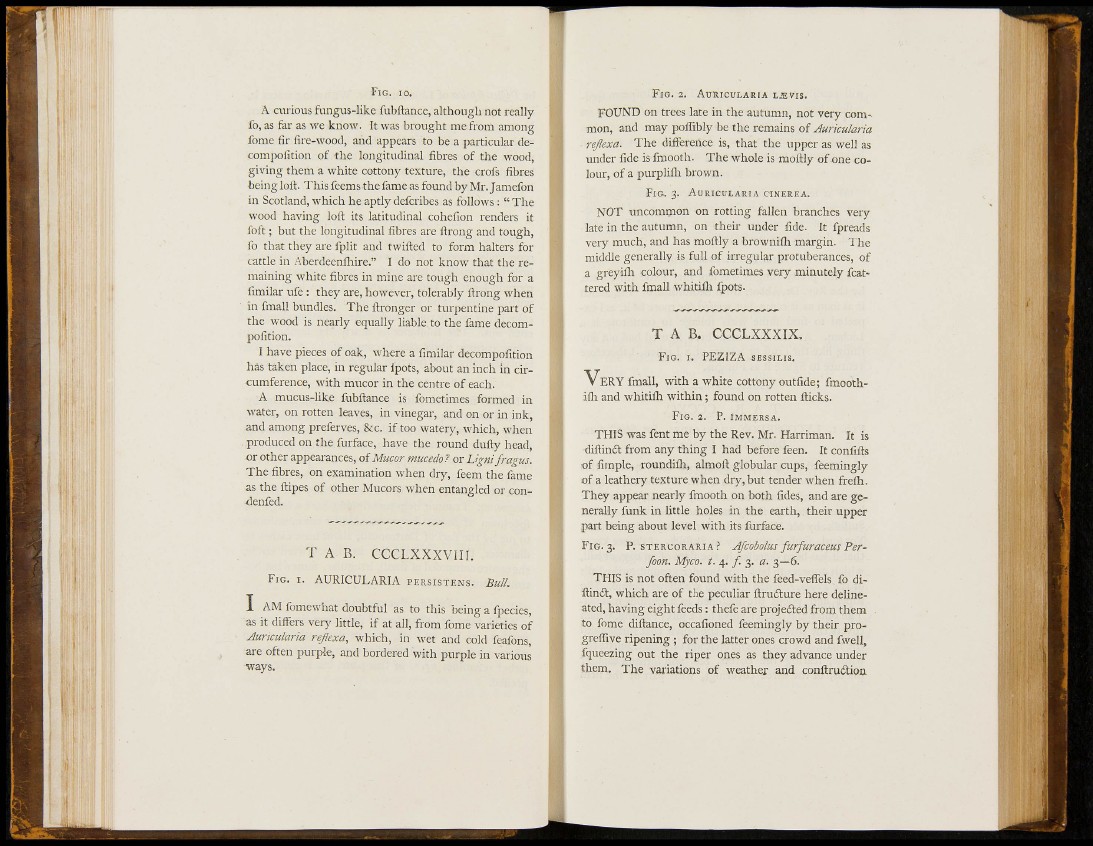
' i f -
w
FIG. 10.
A curious fungus-like fubftance, although not really
fo, as far as we know. It was brought me from among
fome fir fire-wood, and appears to be a particular decompofition
of the longitudinal fibres of the wood,
giving them a white cottony texture, the crofs fibres
being loft. This feems the fame as found by Mr. Jamefon
in Scotland, which he aptly defcribes as follows : " The
wood having loft its latitudinal cohefion renders it
foft ; but the longitudinal fibres are ftrong and tough,
fo that they are fplit and twifted to form halters for
cattle in Aberdeenfliire." I do not know that the remaining
white fibres in mine are tough enough for a
fimilar ufe : they are, however, tolerably ftrong when
in fmall bundles. The ftronger or turpentine part of
the wood is nearly equally liable to the fame decompofition.
I have pieces of oak, where a fimilar decompofition
has taken place, in regular fpots, about an inch in circumference,
with mucor in the centre of each.
A mucus-Uke fubftance is fometimes formed in
water, on rotten leaves, in vinegar, and on or in ink,
and among preferves, &c. if too watery, which, when
produced on the furface, have the round dufty head,
or other appearances, of Mucor mucedo ? or Lignifragus.
The fibres, on examination when dry, feem the fame
as the ftipes of other Mucors when entangled or condenfed.
T A B. CCCLXXXVIIL
F I G . I. AURICULARIA PERSISTENS. Bull.
I AM fomewhat doubtful as to this being a fpecies,
as it differs very little, if at all, from fome varieties of
Auncularia reflexa, which, in wet and cold feafons,
are often purple, and bordered with jrarple in various
ways.
F I G . Z. ATTSICITLARIA LMVIS.
FOUND on trees late in the autumn, not very common,
and may poiTibly be the remains of Aurkularia
reflexa. The difference is, that the upper as well as
under fide is fmooth. The whole is moftly of one colour,
of a purplifli brown.
FIG. 3. AURIGULARIA CINEREA.
NOT uncommon on rotting fallen branches very
late in the autumn, on their under fide. It fpreads
very much, and has moftly a brownifli margin. 1 he
middle generally is full of irregular protuberances, of
a greyiih colour, and fometimes very minutely fcattered
with fmall whitilh fpots.
T A B . CCCLXXXIX.
FIG. I. PEZ1ZA SESSILIS.
V E R Y fmall, with a white cottony outfide; fmoothiili
and whitifli within ; found on rotten flicks.
F I G . 2. P. IMMERSA.
THIS was fent me by the Rev. Mr. Harriman. It is
diftinft from any thing I had before feen. It confifts
of fimple, roundiih, almoft globular cups, feemingly
of a leathery texture when dry, but tender when freih.
They appear nearly fmooth on both fides, and are generally
funk in little holes in the earth, their upper
part being about level with its furface.
F I G . 3. P. STERCORARI A ? Afcobolus furfuraceus Perfoon.
Myco. t. 4. f. 3. a. 3—6.
THIS is not often found with the feed-veffels fo diflinil,
which are of the peculiar ftrufture here delineated,
having eight feeds : thefe are projeiled from them
to fome diftance, occafioned feemingly by their progreffive
ripening ; for the latter ones crowd and fwell,
fqueezing out the riper ones as they advance under
them. The variations of weather and conilruólioa